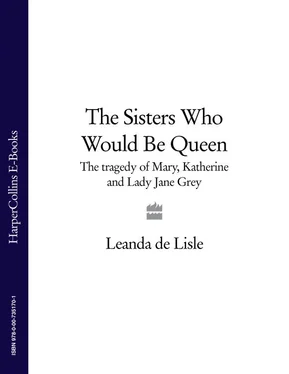1 ...8 9 10 12 13 14 ...24 If there was one thing that would have advanced Sudeley’s ambitions more effectively than marrying a King’s widow, it would be to have married a King’s daughter. Jane’s enquiring mind and sharp eyes could not fail to have noticed how especially friendly Sudeley was with the Princess Elizabeth. Whenever the Queen dowager and her stepdaughter visited them at Seymour Place he was always up first and, still in his nightshirt and slippers, he would breeze down the corridors to the door of Elizabeth’s chamber, look round and wish her good morning. Elizabeth’s governess Kate Astley warned Sudeley that it was ‘an unseemly sight to go to a maiden’s bedchamber barelegged’ and was causing gossip amongst the servants. But Sudeley retorted that he was doing nothing wrong. Soon he was going into Elizabeth’s room. Sometimes she was still in bed and he would ‘put open the curtains, and bid her good morrow, and make as though he would come at her’. 12 Elizabeth did not dare reprove him. She had not forgotten Sudeley was the brother of the Protector: as he made his advances she simply shrank under her covers.
Increasingly Elizabeth’s feelings towards her stepfather became confused. Having a powerful figure show her so much attention was exciting and, at just fourteen, it was not easy to distinguish predator from protector. There may have been an element too, of wanting to revenge herself on her stepmother for her betrayal of her father in marrying so quickly after his death. There is only one time, however, that Elizabeth’s emotions are recorded as having come to the surface, during this period. This was when, to her great distress, her young tutor, William Grindal, died of plague at the end of January. Sudeley and Catherine were anxious to choose his replacement, but here, outside the complex parameters of the adult, sexual arena, Elizabeth’s natural self-assurance could show through, and she insisted on making her own choice: a man she could trust. She picked the thirty-three-year-old Roger Ascham, who had taught Edward alongside John Cheke and been Grindal’s tutor at Cambridge.
Jane also liked Ascham. He was easy-going with a taste for good wine and gambling at cards. He got on particularly well with the Astleys, with whom he recalled enjoying ‘free talk, always mingled with honest mirth’, and Jane would later write a letter commending him to a future employer. * Outside the schoolroom, however, Sudeley’s reckless familiarity with Elizabeth was beginning to cause tensions in his marriage. Sudeley and Catherine enjoyed a passionate, but volatile relationship. He was a jealous lover and Catherine was sometimes frightened of his rages. But she was now pregnant and had her own anxieties. At thirty-six she was old for a first-time mother and feared Sudeley saw Elizabeth as a potential replacement, were she to die in childbirth. There were even rumours, which she may have heard, that Sudeley had expressed an interest in marrying the princess before he had begun to woo her. 13
Kate Astley’s complaints about Sudeley’s behaviour with Elizabeth had resulted in the Queen dowager deciding to accompany Sudeley on his early morning perambulations. But she couldn’t be with him all the time. The final straw for Catherine came in May when she was six months pregnant. Elizabeth and Sudeley had disappeared and Catherine went looking for them. When she found them Elizabeth was in her husband’s arms. 14 Catherine and Sudeley had a furious row. The embrace does not seem to have been overtly sexual, but Catherine later explained to a shocked Elizabeth the grave risk she had taken with her reputation. As the daughter of an infamous adulteress, Elizabeth had more reason than most to be careful with her good name. To prevent any further opportunity for scandal or for some misdeed on Sudeley’s part, Catherine suggested Elizabeth stay for a while with Astley’s sister, Joan Denny. The chastened Elizabeth left a week after Pentecost, ashamed and shaken by what had occurred.
It was Jane alone who accompanied Catherine Parr to her guardian’s Gloucestershire estate at Sudeley for the summer. The orphaned Elizabeth must have reflected bitterly that Jane would now replace her in Catherine’s attentions. If she had felt any malice towards Catherine, it had vanished and she felt remorseful that she had allowed herself to hurt a woman who had shown her nothing but warmth and generosity. For Jane, on the other hand, there was a danger Elizabeth’s leaving would encourage a sense of entitlement. While the illegitimate Elizabeth was banished, she, who was the apple of her father’s eye, took her place as the princess of the households. Sudeley, meanwhile, still didn’t acknowledge that he had behaved irresponsibly with Elizabeth. ‘Suspicion,’ as he wrote in one of his poems, ‘I do banish thee.’ He was a ‘master of noble blood…of manner good, And spotless in life.’ His behaviour was simply, ‘sporting’. 15 He was now only looking forward to fatherhood. He liked to hear Catherine describe how his child was stirring in her womb and shared with her his hopes of a son who would grow up to avenge all the humiliations they endured at his brother’s hands. He had prepared a nursery at his house furnished for a prince. There were scarlet curtains of silk taffeta, a chair upholstered in cloth of gold, carved stools, rich hangings, carpets and a gilded salt. All the signs of the baby’s expected arrival were there, from the cradle where he would sleep, to the three feather beds and goblets for his nurse and servants. 16
Jane had to get used to the noise of further extensive building works while she was at Sudeley House. Her guardian was spending a fortune on his Gloucestershire seat (although nothing like the £10,000 his brother spent that year alone on Somerset House). But it was a happy time for Jane, studying under the Queen dowager’s guidance and with a fine library of books to read. There were upwards of twenty-two volumes in Catherine’s personal collection, some in English, others in French or Italian. Only seven, however, were religious works: Catherine was losing her passion for theology. Sudeley even seemed bored by the twice-daily prayers given by the chaplains. Hugh Latimer, who was the spiritual adviser of Jane’s stepgrandmother, complained later he avoided them ‘like a mole digging in the dirt’. 17 If Jane reflected on this she would have worried that he was tempting fate: God punished such behaviour, she was taught.
In August, when the baby was almost due, Jane’s father came to visit and she was able to catch up with family news. Her sister, Katherine, who had just turned eight, was now studying Greek with the new chaplain, Thomas Harding, a former Regius Professor of Hebrew at Oxford. She did not show the same aptitude for her studies as Jane, but she made up in charm what she lacked in intellectual drive. Everyone liked Katherine. Little Mary Grey was also doing well. Jane could imagine her dashing about, the long tippets sewn at her shoulders known as the ‘ribbons of childhood’ streaming behind her as she ran and played: a small, determined figure, as yet ignorant that she was not the beauty her sisters were said to be. There was news too, for Jane, of the extended family, and especially the sisters’ uncle, Lord John Grey, who was commanding cavalry in the war with Scotland. Somerset hoped to achieve what King Henry had failed to do and unite the two kingdoms, by marriage or force. The family was fearful for Lord John after the almost fatal injuries he had received at the battle of Pinkie in September 1547, but they thought his troops had cut a fine spectacle when they had left London in July, dressed in blue coats guarded in yellow, and he had, thus far, survived this campaign unhurt. 18
Sudeley was anxious, however, to discuss other matters with Jane’s father and, when the adults were alone, Dorset found him full of plans. To Sudeley’s delight, his brother, the Protector, had begun to make enemies. There were those who felt the evangelical reformation was losing impetus. The radical preacher, John Knox, later complained that Somerset spent more time with his masons than he did with his chaplains. And the regal style of his Italianate palace irritated on a further account: it reflected the lofty attitude he held towards his colleagues. There were profound concerns about the expense of the war with Scotland and the high inflation the country was suffering, but Somerset was dismissive of the anxieties of his fellow Councillors and sometimes even appeared contemptuous of them. He had brutally expelled Sudeley’s brother-in-law, William Parr of Northampton, from the Privy Council for taking the novel step of divorcing his wife and marrying his mistress, the court beauty Elizabeth Brooke - an action that reflected, in turn, Somerset’s fears that parts of the country were restive over the religious changes already introduced. 19
Читать дальше












